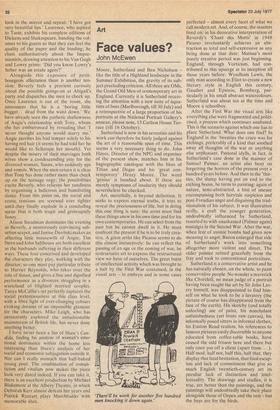Art
Face values?
John McEwen
Moore, Sutherland and Ben Nicholson — like the title of a Highland landscape in the Summer Exhibition, the gravity of its sub-' ject precluding criticism. All three are OMs, the Grand Old Men of contemporary art in England. Currently it is Sutherland receiving the attention with a new suite of aquatints of bees (Marlborough, till 30 July) and a retrospective of a large proportion of his portraits at the National Portrait Gallery's annexe, please note, 15 Carlton House Terrace (till 16 October).
Sutherland is now in his seventies and his work can therefore be fairly judged against the art of a reasonable span of time. This seems a very necessary thing to do. John Hayes, Director of the NPG and organiser of the present show, matches him in his hagiographic catalogue with the likes of Titian and Degas and his `great contemporary' Henry Moore. The word 'genius' is bandied about. If these are merely symptoms of insularity they should nevertheless be checked. • Art, mercifully, is beyond definition. It seeks to express eternal truths, it tries to reveal the preciousness of life, but in doing this one thing is sure: the artist must find these things anew in his own time and for his own contemporaries. He can select from the past but he cannot dwell in it. He must confront the present if he is to be truly creative. A great artist like Picasso seems to do this almost instinctively: he can reflect the passing of an age or the coming of war, he restructures art to express the restructured view we have of ourselves. The great burst of intellectual activity which was brought to a halt by the First War contained, in the visual arts — in embryo and in some cases perfected — almost every facet of what we call modern art. And, of course, the masters lived on: in his decorative interpretation of Reverdy's 'Chant des Morts' in 1948 Picasso involuntarily achieves an abstraction as total and self-expressive as any being done at that date: Matisse's most purely creative period was just beginning. England, through Vorticism, had contributed to this upsurge at its inception all those years before: Wyndhatn Lewis, the only man according to Eliot to create a new literary style in English this century, Gaudier and Epstein, Bamberg, particularly in his small abstract watercolours. Sutherland was about ten at the time and Moore a schoolboy.
After the First War the visual arts like everything else were fragmented and politicised, a process which continues unabated. This is the scenario against which one has to place Sutherland. What does one find? In England in the 'twenties the craze was for etchings, preferably of a kind that soothed , away all thoughts of the war or anything else unpleasant. Pastoral idylls, in fact, in Sutherland's case done in the manner of Samuel Palmer, an artist also bent on forgetting the horrors of the present over a hundred years before. And then in the 'thirties, the slump having put an end to the etching boom, he turns to painting: again of nature, semi-abstracted, a hint of unease encompassing both fairytale suspicion and post-Freudian angst and disguising the traditionalism of his subject. It was illustration really, a craft the younger generation, undoubtedly influenced by Sutherland, resorted to with unashamed (Palmer again) nostalgia in the Second War. After the war, when fear of atomic bombs had given new meaning to angst, Bacon enlarged that side of Sutherland's work into something altogether more violent and direct. The older painter retired gracefully from the fray and took to conventional portraiture.
Sutherland is a conservative artist and he has naturally choSen, on the whole, to paint conservative people. No wonder a maverick like Churchill, no mean judge of a portrait having been taught the art by Sir John Lavery himself, was disappointed to find himself on what he took to be a lavatory (the picture of course has disappeared from the face of the earth). His sketchy (and totally unfeeling) use of paint, his nonchalant unfinishedness (art brute raw canvas), his informally posed sitters in informal clothes, his Euston Road realism, his references to famous pictures easily discernible to anyone educated from coffee-table books, have caused the odd frisson here and there but only once put off a client (apart from... ). Half mod, half not, half this, half that, they display that fatal hesitation, that final escapism and lack of commitment that give so much English twentieth-century art its peculiar lack of distinction and intellectuality. The drawings and studies, it is true, are better than the paintings, and the paintings will undoubtedly take their place alongside those of Orpen and the rest — but the bees are for the birds.






































 Previous page
Previous page